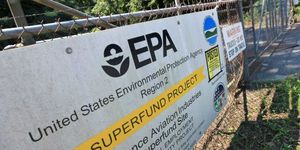Burning Greenland: the low-down about wildfires on an ice sheet
Wildfires in Greenland seem like an oxymoron; how could a landmass made of ice be burning? Well, it’s because Greenland isn’t just made of ice, it’s made of peat, too. Peatland, also known as bog or moor, is the layers on layers of carbon-rich organic matter built up over millions of years. Hotter and dryer conditions in the region have caused melting of Greenland’s ice sheet which in turn makes vast amounts of peatland vulnerable to dry out. Once dry, peatlands are dangerously susceptible to wildfires.
Although it’s unknown for sure what started this wildfire, officials say it was likely a bonfire gone wrong. Wind could have carried sparks from Greenland’s second largest town, Sisimiut, to the areas of exposed peatland. “These fires appear to be peatland fires,” wildfire expert Jessica L. McCarty told Wildfire Today. “They are likely occurring in areas of degraded permafrost, which are predicted to have high thaw rates between now and 2050.”
Peatland fires are doubly dangerous because they can set off several feedback mechanisms, none of which are good for our warming planet; not to mention that they usually burn for weeks until all the organic matter has burned to ash. According to a 2015 study, “Globally, the amount of carbon stored in peats exceeds that stored in vegetation and is similar in size to the current atmospheric carbon pool.” Because peatlands are such good carbon sinks, when they burn, all of that carbon enters the atmosphere. Smoldering peat fires have the largest carbon footprint, the 2015 study reports.
You’re probably already aware of the chain reactions that set off from more carbon in the atmosphere. Higher temperatures mean faster melting ice. Since the mid-1990s, ice melt in Greenland has increased five-fold.
But that’s not it. Shifting winds could move soot from the wildfire to other parts of the ice sheet, thus darkening the surface of the ice. When the ice is darker in color, it absorbs more heat, a phenomenon called albedo. That in turn also works to speed up melting.
And that’s STILL not all. As the Greenland ice sheet continues to shrink due to rising temperatures, shrubification will also ensue on the peatland as a result of increased precipitation and a longer growing season. More vegetation plus erratic weather events such as droughts and thunderstorms all combine to form the perfect wildfire recipe for disaster.
“Everything we know suggests that fire will increase in the Arctic,” climate scientist Jason Box, commented to Mother Jones. “It’s fair to say that it’s part of the pattern of warming. We should see more such fires in Greenland.”
The Greenland fire, which is the largest the region has experienced as far as scientists know, isn’t an anomaly. A 2013 study found that across the Arctic, forests are burning at a rate unseen in at least 10,000 years.
Sources: Think Progress, Mother Jones









